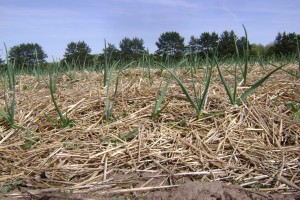 Most people think they know garlic. But did you know there are hundreds of varieties? Most people are only familiar with the white California garlic found in grocery stores. We don’t grow that kind here; it doesn’t do well in cold climates. However, most varieties of garlic do do well in cold climates. Garlic is thought to have originated in the colder parts of Asia. It was just luck that California found a variety that grew in their warmer climate.
Most people think they know garlic. But did you know there are hundreds of varieties? Most people are only familiar with the white California garlic found in grocery stores. We don’t grow that kind here; it doesn’t do well in cold climates. However, most varieties of garlic do do well in cold climates. Garlic is thought to have originated in the colder parts of Asia. It was just luck that California found a variety that grew in their warmer climate.
There are two main types of garlic: softneck and hardneck. These can be further subdivided, but for the purposes of this article the distinction between the two main types is sufficient. Softneck garlic is like the California garlic. The neck of the plant is soft and looks like a bunch of strappy leaves similar to onions. Hardneck garlic has a stiff neck. The reason to bring up this distinction is that the neck of the hardneck garlic plant sprouts a “scape”, which is an ancient form of a flower.
 We provide three different crops from our planting of garlic. In the spring we harvest immature garlic plants, known as green garlic. It is similar to the familiar green onions, though garlic instead of onions. Green garlic is more mild than its more mature bulb form. The whole garlic plant can be used — leaves and all. There is no need to peel the cloves, in fact it may be impossible to peel. You can just chop it up and put it into any dish you’d like to season with garlic.
We provide three different crops from our planting of garlic. In the spring we harvest immature garlic plants, known as green garlic. It is similar to the familiar green onions, though garlic instead of onions. Green garlic is more mild than its more mature bulb form. The whole garlic plant can be used — leaves and all. There is no need to peel the cloves, in fact it may be impossible to peel. You can just chop it up and put it into any dish you’d like to season with garlic.
The second crop is the aforementioned garlic scapes. Much like green garlic, all parts of garlic scapes are edible. Garlic scapes can be used similar to green garlic. They can be added to a pesto or roasted in the oven (smaller and younger scapes work best for this). They work well in soups, pasta sauces, even salads if you like the flavor of raw garlic; use them anywhere you want to add a fresh garlic flavor in the spring. Larger garlic scapes tend to be more fibrous and are best chopped fine prior to use.
The final crop from our garlic planting are the garlic bulbs. We harvest them in late July/early August. After harvest they are hung up to cure for a few weeks. The curing process helps the garlic to store over the winter.
Cooking with Garlic
The most important thing to remember when cooking with garlic is to not burn the garlic. Burned garlic does not taste nearly as good as non-burned garlic. How to prevent burning you ask? If you are sauteing or stir frying, don’t put the garlic in with the onions. Garlic cooks faster than onions. Add the garlic when only a few minutes of higher heat remains. It only needs to cook a bit to release the flavor. However it is best to add it before you add any liquid (tomatoes, water, etc.) to allow the higher heat to release the flavors.
